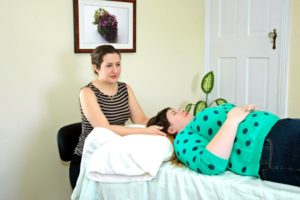What is craniosacral therapy?
 Craniosacral therapy (CST) is a gentle form of bodywork which can promote relaxation and release of restrictions in the body. In a craniosacral therapy session, the practitioner works with the body’s craniosacral system which consists of the layers of connective tissue (fascia) surrounding the brain and spinal cord, the bones of the skull and sacrum, and the cerebrospinal fluid which ebbs and flows through these structures. Through light touch and gentle pressure, the practitioner can feel for changes or blockages in the flow of the craniosacral rhythm and help allow them to release.
Craniosacral therapy (CST) is a gentle form of bodywork which can promote relaxation and release of restrictions in the body. In a craniosacral therapy session, the practitioner works with the body’s craniosacral system which consists of the layers of connective tissue (fascia) surrounding the brain and spinal cord, the bones of the skull and sacrum, and the cerebrospinal fluid which ebbs and flows through these structures. Through light touch and gentle pressure, the practitioner can feel for changes or blockages in the flow of the craniosacral rhythm and help allow them to release.
What happens in a session?
During a craniosacral session, the client lies fully clothed on the table. The practitioner places her hands on different areas of the body where she feels restrictions in the craniosacral rhythm. She may work over the sacrum, along the spine, with the bones of the skull, over joint articulations, or over the chest and abdomen. Within a craniosacral session, the client can drift into a relaxed state to safely and comfortably let go of tension and stress.
Some of the benefits you may experience with craniosacral therapy include:
- Breathing deeper and easier
- Sense of Calm and Relaxation
- Release of old injury patterns
- Relaxation of tight muscle tissue
- Decrease in headache frequency and intensity
- Increased range of motion in joints
- Improved Posture
- Decreased jaw tension
- Relief of Low Back Pain
- Decreased pressure in sinuses
What else should I know about craniosacral therapy?
- Sensations During Treatment:
The movements and changes in pressure that practitioner uses are physically very subtle, but the client may feel sensations ranging from warmth, coolness, tingling, pressure, mild pain, relief of pain, or pulsing. If a sensation is ever uncomfortable or too intense, it is very important that you notify the practitioner. - Sensations After the Treatment
After a craniosacral session, a client may experience mild lightheadedness or soreness in worked body areas. One or two days following a treatment certain body areas may feel a bit worse before they feel better. Whereas this does not always occur, it is a normal response to beginning CS treatment. - Emotional Release:
Along with treating the physical body, craniosacral therapy can also allow for the release of old emotions associated with past traumas. Some clients may experience an emotional release during a session or several days afterwards. This is a normal part of releasing old restrictions from the body connected to emotional experiences. - Noticing Results:
Depending on how long a particular physical or emotional concern has been present, it may take several sessions before noticing significant results. Your practitioner will discuss your progress with you and make appropriate referrals to other healthcare practitioners as needed. CST is not a substitute for standard medical care and is not meant to diagnose or act as a sole treatment for a health condition. - If you notice any adverse effects from your treatment, it is important to notify your practitioner.